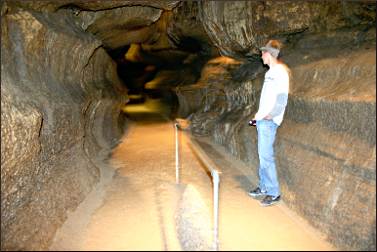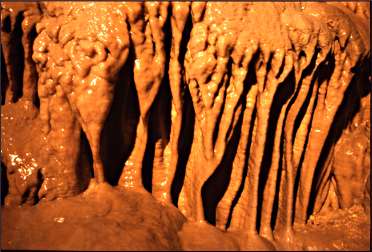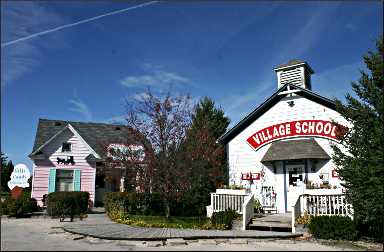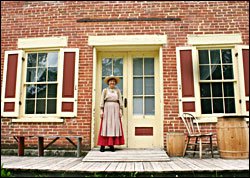Minnesota's cave country
In the southeast corner of the state, scratch the surface for a glimpse of splendor.

© Beth Gauper
Under the cornstalks of Fillmore County, an unusual sculpture garden sits in shadow.
Stalagmite topiaries line walkways, alongside pale-green flowstone as translucent as Chinese jade. Stalactite statuettes dangle in artistic arrays.
They're obviously created by a Pollock of rock, a Van Gogh of stone. Yet their genius relies not on the medium — water, applied one drop at a time — but on eons worth of time.
A billion years ago, the floor of this underground garden was the silty muck on the bottom of a tropical sea, encrusted with the shells of mollusks. Over time, it compressed into porous limestone, cut through by underground streams.
Rain, acid and gases ate cavities in the stone, and the streams carved twisting labyrinths, picking up minerals that colored the walls — manganese for purple and brown, iron oxide for red and orange, calcite for white and yellow.
Rivulets laden with these minerals dripped into the cavities, spreading tapestries of flowstone along the walls, glistening stalactites overhead and nubby stalagmites on the ground.
They're still growing, as are the chalk-white soda straws — baby stalactites, lengthening by an inch a century — that carpet ceilings.
Niagara Cave was discovered in 1924, when three pigs disappeared from a farm near Harmony. The farmer, looking for his missing pigs, found a sinkhole — a spot where the thin layer of limestone under the soil has collapsed — and sent some neighbor boys down by rope.
Seventy-five feet later, they found the pigs — still alive — and a huge labyrinth of underground canyons. Tours began in 1934 and still start from the pigs' landing spot, the Reception Room.
Mystery Cave was discovered on a frigid day in 1937, by a man walking along the South Branch of the Root River. Because the air inside the cave is 48 degrees Fahrenheit year-round, it had melted the snow on the ground around a sinkhole, and steam was rising from it.

© Beth Gauper
He found a whole system of caverns, and tours of Mystery Cave, now part of Forestville/Mystery Cave State Park, started 10 years later.
In summer, a visit to these underground caverns is a good way to beat the heat, since the air always is a bracing 48 degrees.
The cold also is responsible for Fillmore County's status as a trout-fishing mecca; water that takes a short cut through the caves rejoins the South Branch of the Root River chilled to 48 degrees, allowing trout to thrive.
"If it weren't for the caves, you'd have to pack up and go to Montana to find trout," said Chris Ingebretsen, a DNR naturalist who begins his tours by showing visitors the nearly dry bed of the South Branch as it skirts the caves.
The surrounding countryside, he said, looks ordinary, even bucolic. But appearances are deceiving.
"It's karst topography, which means there's fractured limestone right under the surface, and water drops down into the fractures and disappears," he said. "It's odd country — there's not a lot of solid ground in Fillmore County."
Ingebretsen was leading a tour of Minnesota Caverns, also known as Mystery 2; there's also a Mystery 3, he said, along the 13-mile system.
Most people who go on the Mystery 2 tour, held only on summer weekends, already know something about caves. My group was handy with answers — "What forms stalagmites?" "Water dripping off stalactites!" and "How do bats navigate?" "Echo location!"
He described the sculpting powers of water, aided by carbonic acid, also used in soda pop — "Most people don't give a lot of thought to the fact they're drinking something that makes rock dissolve" — and led us through triangular rooms.
On the walls, fossilized worm burrows created a Swiss-cheese effect. Pure-white helictites twisted and curled, and a beautiful, pale-orange carrot stalactite (think "c," for "ceiling") reached toward the floor.
One pale-green, translucent stalagmite (think "g," for ground") looked just like the Minneapolis Institute of Art's famous "Jade Mountain."
At the end of the two-hour tour, we emerged into daylight, our chilled hands tingling in the summer heat.

© Torsten Muller
The one-hour tours of Mystery Cave are held daily in summer and hold another set of oddly shaped wall patterns, evocative stalactites, 5-foot fossils — and bats, 2,000 of which hibernate in the cave.
For many visitors, they're the highlight, and on my tour, we could see furry little clusters of them snoozing in nearly every chamber.
Bats, explained naturalist Angela McKay, use sound waves to find mosquitoes to eat and obviously have no problem knowing where people are, as long as the people don't move suddenly.
We must have been listening, because when two bats started zooming around we just stood and watched.
"You're much calmer than most people when bats are flying around," McKay told us.
They weren't the only residents of the cave. On lovely Turquoise Lake, its surface perfectly reflecting the ceiling, McKay pointed out white specks sitting on calcite rafts — springtails, a wingless insect that survives on lint and dead skin cells brought in by visitors.
Twenty-two miles southeast, less than a mile from the Iowa border, Niagara Cave traditionally has had the goofier tours, in the grand tradition of 1950s-style kitsch.
But then former Rochester real-estate agent Mark Bishop, who has a degree in earth sciences, bought the cave and adjoining house and gift shop.

© Beth Gauper
"Paul Bunyan moved out when I moved in," Bishop said with a laugh, referring to the narrow ledge dubbed "Paul Bunyan's bed" by previous guides. "I wanted the tours to be a little educational, and also fun."
Today, the cave glows with lighting so artfully arranged that each chamber and passageway has the shadowed elegance of an Ansel Adams photo. "I spent three winters up in the crevices, arranging the lights," Bishop says.
Still, the cave has formations that really do look like an Elephant's Head, a three-tier Wedding Cake and a battleship, and guides point them out.
They also show visitors a frighteningly realistic, five-fingered skeleton's hand: "Some guides, they'll tell you this is what they'll do to you if you touch the walls," teased our guide, high-school student Amanda Bruggman.
When people touch a formation, their fingers give it a layer of oil that makes dripping water slide off, and the formation stops growing. That didn't stop the boy in front of me from touching one — "Oh, who cares," he muttered under his breath.
Niagara Cave also has a 60-foot waterfall, viewed from a suspended walkway; twisting Cathedral Dome, formed by a whirlpool; and a 625-foot Grand Canyon room — all features that make people say, "Wow."
My own favorite feature was a rock passageway, indented as if a giant had pressed his thumb into clay thousands of times.
I'm also partial to the ribbon stalactites, also known as cave bacon, and the sharks-tooth stalactites, fat on one side and skinny on the other.
In these caves, there's a masterpiece around every corner. They weren't created by chisel or brush, but a visitor's reaction to them — awe — is always just the same.
Trip Tips: Southeast Minnesota caves near Harmony
Getting there: Harmony is just over the Iowa border, 2¼ hours south of the Twin Cities.
What to bring: A warm jacket and good walking shoes.
Niagara Cave: It's open daily May through October and weekends in April; otherwise by appointment. The one-hour tour costs $20.95, $12.95 for children 3-12.
The shady grounds include a pavilion and are a nice place for a picnic. To get there, drive 2½ miles south of Harmony on County Road 139, then two miles west on County Road 30. 800-837-6606.

© Beth Gauper
Mystery Cave: Hour-long, half-mile tours of Mystery Cave are handicapped-accessible, on lighted concrete walkways, and are given daily between Memorial Day and Labor Day, weekends from mid-April through May and in October.
There's also a one-hour lantern tour, a two-hour geology tour and a two-hour photography tour.
The entrance is five miles west of Forestville/Mystery Cave State Park. From Minnesota 16 between Spring Valley and Preston, take County Road 5 south for four miles, then drive two miles on County Road 118.
A state-park vehicle permit also is required.
Historic Forestville: Costumed interpreters play real people at this real village, frozen in 1899. It's within Forestville State Park but operated by the Minnesota Historical Society.
Check for special events. It's open from Memorial Day weekend to mid-October. Admission is $10, $8 for children 5-7.
For more, see Brigadoon in bluff country.
Accommodations: There are five camper cabins in Forestville/Mystery Cave State Park. Three of them sleep six; two are handicapped-accessible and sleep five.
Preston and Lanesboro have many accommodations, often filled by bicyclists on summer and fall weekends.
For more, see Lodgings in Lanesboro and Bicycling in bluff country.
Dining: On Harmony's Main Avenue, Estelle's Eatery & Bar taps local farms for the ingredients in its popular burgers, soups, salads, pastas and specials, many of which have a global twist.
What else to do: Harmony also is a good place to take an Amish tour.
For more, see Amish country.
And just across the border in Iowa, you can visit the Burr Oak hotel where Laura Ingalls Wilder's family lived, Seed Savers Exchange and the Norwegian town of Decorah and Spillville, a Czech town famous for Dvorak and the Bily Clocks.
For more, see Road trip: Northeast Iowa.